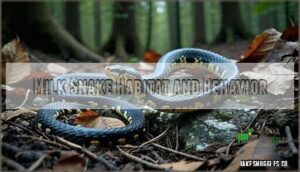This site is supported by our readers. We may earn a commission, at no cost to you, if you purchase through links.

You’ll spot coral snakes by their red bands touching yellow bands, while harmless milk snakes and king snakes have red touching black.
Coral snakes stay smaller with black snouts, whereas king snakes grow larger and can actually eat other snakes.
Milk snakes tend to be more slender with brighter colors, and king snakes are the tough guys of the bunch, constricting their prey with surprising strength.
Knowing these key differences could literally save your life in the wild, as coral snakes and their venom pose a significant threat.
Table Of Contents
- Key Takeaways
- Identification of Physical Characteristics
- Habitat and Behavioral Differences
- Dietary Variances
- Venom and Toxicity Distinctions
- Tips for Differentiation
- Frequently Asked Questions (FAQs)
- How do you tell the difference between a coral snake and a milk snake?
- How to tell the difference between a king snake and a coral snake?
- How to tell the difference between a milk snake and a king snake?
- Is the coral snake rhyme accurate?
- What is the difference between a kingsnake and a milk snake?
- How can you tell a milk snake from a king snake?
- Are milk snakes related to coral snakes or kingsnakes?
- Which snake species makes the best pet?
- How do these snakes lifespans compare in the wild?
- Can milk snakes interbreed with coral or kingsnakes?
- Conclusion
Key Takeaways
- You’ll identify the dangerous one by its bands – coral snakes have red bands touching yellow bands and pack deadly neurotoxic venom, while harmless milk snakes and king snakes have red bands touching black bands and use constriction instead of venom.
- You can distinguish them by size and build – coral snakes stay smaller (18-30 inches) with black snouts and slender bodies, king snakes grow largest (3-6 feet) with glossy scales, and milk snakes remain mid-sized (14-69 inches) with the brightest coloring.
- You’ll find them in different places – coral snakes prefer sandy soils and dry woods in southeastern states, king snakes adapt to diverse habitats across North and South America, while milk snakes choose rocky ground and open woodlands with wider geographic distribution.
- You can’t rely solely on the rhyme – while "red touches yellow, kills a fellow; red touches black, friend of Jack" works for North American species, regional variations and exceptions exist, so you should also check head shape and geographic location for accurate identification.
Identification of Physical Characteristics
You’ll need to look at specific physical traits to tell these three snakes apart, since they all share similar red, black, and yellow coloring that can fool even experienced observers.
The key differences lie in their band patterns, head shapes, and scale types, which we’ll examine to help you make accurate identifications in the field, focusing on complete concepts.
Coral Snake Features
Coral snake identification starts with understanding their deadly beauty. These Elapid Family members showcase nature’s most vivid warning system through their banded patterns.
Nature’s most dangerous serpents wear their warning like jewelry – brilliant bands that whisper deadly beauty.
Unlike their harmless mimics, coral snakes display the dangerous "red touch yellow" combination that signals their potent venom delivery system.
- Smooth, glossy scales that shine like polished jewelry
- Slender build with a distinctively small, rounded head
- Vivid red and yellow bands touching directly together
- Geographic distribution limited to southeastern United States
- Size variations typically ranging from 18-30 inches long
Their neurotoxic venom makes proper identification essential for your safety.
King Snake Features
Moving from coral snakes, king snakes (Lampropeltis) showcase impressive constricting abilities and remarkable venom immunity.
You’ll spot their glossy scale appearance and rounded snouts easily.
These non-venomous champions display size variation from 3-6 feet with red bands touching black bands.
Their habitat preference spans diverse environments across North America.
King snake identification becomes simpler when you remember they’re powerful constrictors that actually eat venomous snakes without harm.
They thrive with temperatures between 78-88°F in their enclosure.
Milk Snake Features
With their striking bands and glossy scales, milk snakes are nature’s master mimics.
These non-venomous constrictors typically measure 14-69 inches, though eastern milk snake subspecies variations can reach impressive lengths.
You’ll notice their smooth, shiny scale patterns and rounded heads that distinguish them from venomous lookalikes.
- Milk snake identification: Red bands touch black bands, never yellow
- Color morphs: Bright red, black, and white/yellow banding patterns
- Subspecies variations: 24 recognized types across North America
- Habitat preferences: Woodlands, grasslands, and rocky areas
Habitat and Behavioral Differences
You’ll find these three snake species in very different places, which makes location a key clue for identification.
Coral snakes prefer sandy soils and dry woods in the Southeast, while milk snakes choose rocky ground and open woodlands across a much wider range.
King snakes adapt to everything from sandy islands to mountain areas throughout North and South America, and this adaptability is a notable characteristic of the species, highlighting the importance of identification.
Coral Snake Habitat and Behavior
Now that you understand their physical traits, let’s explore where coral snakes actually live and how they behave.
These venomous serpents stick to specific geographic distribution patterns across Arizona, Texas, and southeastern states.
Their snake habitat includes sandy soils and wooded areas.
Activity patterns show they’re secretive, burrowing creatures.
Predator avoidance involves hiding underground during daylight hours, making encounters rare despite their high venom potency.
King Snake Habitat and Behavior
Unlike their coral snake cousins, king snakes showcase remarkable Regional Adaptations across diverse snake habitats.
You’ll spot these adaptable hunters from forests to deserts throughout North and South America. Their Activity Patterns peak during daylight hours, when they actively hunt other snakes.
Key snake behavior traits include:
- Burrowing Habits in loose soil and leaf litter
- Impressive climbing abilities on trees and rocks
- Defensive Predator Interactions through aggressive displays
Their Conservation Status remains stable due to habitat flexibility.
Milk Snake Habitat and Behavior
Milk snakes adapt to remarkably diverse environments across their range.
You’ll spot these nonvenomous snakes in woodlands, grasslands, rocky hillsides, and even your backyard.
Eastern milk snake populations prefer well-drained soils and sparse vegetation.
Their snake behavior includes nocturnal hunting and excellent climbing abilities.
Snake habitat preferences show regional variations – northern populations hibernate longer than southern ones.
Activity patterns peak during twilight hours.
Despite frequent human interaction, their conservation status remains stable.
These secretive reptiles practice peaceful coexistence with other species while controlling rodent populations effectively, demonstrating their importance in the ecosystem with effective population control.
Dietary Variances
You’ll find that these three snake species have different eating habits that can help you tell them apart in the wild.
Coral snakes prefer small lizards, frogs, birds, and other snakes, while king snakes eat similar prey but also hunt venomous snakes in their area.
Milk snakes focus more on small rodents, mammals, slugs, and bird eggs, which distinguishes them from the other two species in terms of their prey.
Coral Snake Diet
Coral snakes prefer a menu that’s surprisingly picky.
These venomous hunters focus on snake prey and small lizards, using their neurotoxic venom to subdue victims quickly.
Their hunting strategies involve ambush tactics in tight spaces where larger predators can’t follow.
Regional variations show Texas coral snakes favoring blind snakes, while Florida species target skinks and small serpents.
Juvenile diets mirror adults but focus on smaller prey like worm snakes.
Their specialized dietary adaptations make them efficient reptile controllers in their ecosystems.
This contrasts sharply with the extreme caloric restriction seen in some fad diets.
King Snake Diet
King snakes earn their royal reputation through ophiophagy – they’re literal snake eaters with remarkable venom immunity.
These powerful constrictors use prey constriction to subdue everything from rodents to rattlesnakes.
Juvenile diet starts with smaller lizards, while adults tackle larger prey.
Feeding frequency varies seasonally, with regional variations affecting available food sources.
- A king snake wrapping around a venomous copperhead, completely immune to its deadly bite
- Powerful coils squeezing the life from a struggling rat in complete silence
- Sharp teeth gripping a smaller snake while muscular body delivers the fatal embrace
Milk Snake Diet
Most milk snakes are opportunistic hunters with varied appetites.
They’ll devour small rodents, birds, eggs, and even other snakes – a behavior called ophiophagy.
Prey size increases as they mature, with juveniles targeting insects while adults tackle mice and small reptiles.
Their hunting strategies involve constriction, and seasonal variations affect feeding frequency.
Regional differences in available prey shape local diets.
Captive feeding typically involves frozen-thawed rodents, making snake diets manageable for keepers.
Venom and Toxicity Distinctions
When you’re trying to tell these snakes apart, the most important thing you need to know is which one can actually hurt you.
Only coral snakes pack deadly venom that affects your nervous system, while both king snakes and milk snakes are completely harmless constrictors that squeeze their prey instead of injecting toxins.
Both king snakes and milk snakes are completely harmless, which makes them distinct from the venomous snakes, and they squeeze their prey instead of injecting toxins.
Coral Snake Venom and Its Effects
When you encounter a coral snake, you’re facing serious danger.
Coral snakes pack deadly neurotoxic venom – their vivid warning bands signal real danger lurking beneath nature’s most beautiful disguise.
Their neurotoxic venom contains powerful proteins that attack your nervous system directly. Bite symptoms start subtly – minimal pain at first – but venom potency quickly leads to muscle paralysis and breathing problems.
The venom composition includes phospholipases and three-finger toxins that disrupt nerve signals. Snake bite symptoms progress rapidly, potentially causing respiratory failure within hours.
Antivenom treatment is most effective if administered promptly after a bite. Medical treatment requires immediate medical attention and antivenom to prevent long-term effects. Don’t wait – snake venom from coral snakes demands emergency care, for more information visit <strong>Antivenom treatment</strong>.
King Snake Non-venomous Nature
Unlike their venomous lookalikes, king snakes pose zero threat to humans.
These non-venomous snakes use king constricting methods to subdue prey, not venom.
They’re immune to other snakes’ venom, making them nature’s pest controllers.
King snake benefits include controlling rodent populations and eliminating dangerous species.
Despite king snake myths suggesting otherwise, they’re docile creatures.
King snake safety is excellent—their bites are harmless, making them beneficial backyard neighbors.
Milk Snake Venom or Lack Thereof
The good news about milk snakes? They’re completely harmless to humans despite their dangerous appearance.
These non-venomous snakes rely on mimicry for protection, copying coral snake colors without the deadly bite.
Here’s what makes milk snake bites different:
- No venom glands or hollow fangs
- Tiny teeth that barely break skin
- Constriction hunting instead of poison
- Safe handling with proper precautions
- Beneficial pest control around homes
Tips for Differentiation
You’ll need to focus on three key features to tell these snakes apart: color patterns, head shape, and size differences.
The famous rhyme "red touches yellow, kills a fellow; red touches black, friend of Jack" works for North American species, but you should also check the snout shape since coral snakes have pointed heads while king snakes and milk snakes have rounded ones.
Color Pattern Comparison
Color patterns tell the whole story when you’re dealing with these look-alikes. The band arrangement makes all the difference between a dangerous coral snake and harmless mimics.
Red touches yellow on coral snakes – that’s your warning sign. King snakes and milk snakes keep black bands between red and yellow, creating a safer profile.
- Pattern reliability: Coral snakes display consistent red-yellow contact while king snake vs milk snake variations show black separation
Remember this lifesaver: "Red touches yellow, kill a fellow; red touches black, friend of Jack."
Color variation exists, but mimicry defense evolved to confuse predators – and sometimes us. Understanding a snake’s color variations can further aid identification.
Snake color patterns don’t lie when you know what to look for.
Snout Characteristics
Beyond color patterns, snout shape offers another reliable snake identification guide. You’ll notice distinct differences when comparing these species up close.
| Feature | Coral Snake | King Snake | Milk Snake |
|---|---|---|---|
| Snout Shape | Short, blunt | Long, rounded | Pointed, narrow |
| Nostril Position | Small, forward-facing | Large, side-positioned | Medium, slightly raised |
| Scale Patterns | Smooth, small scales | Larger, overlapping scales | Flat, uniform scales |
Snout length varies substantially between species. Coral snakes have shortened, blunt snouts with black facial markings extending behind their eyes. King snakes feature lengthened, rounded snouts that help distinguish them from their venomous lookalikes.
Remember that scale texture can vary between species. These facial markings and nostril position details can save your life during field identification.
Rhyme for Coral and King Snakes
You’ll recognize the famous snake rhyme: "Red touch yellow, kill a fellow; red touches black, friend of Jack."
This mnemonic was created by Boy Scouts for coral snake vs king snake identification. However, rhyme reliability has rhyme limitations due to regional variations in snake coloring.
Alternative rhymes exist, but experts warn against relying solely on these mnemonic origins for snake identification in milk snake vs coral snake situations.
Pet owners should be aware of snake identification methods to guarantee pet safety.
Frequently Asked Questions (FAQs)
How do you tell the difference between a coral snake and a milk snake?
Remember this simple rhyme: "Red touches yellow, you’re a dead fellow; red touches black, you’re okay, Jack."
Coral snakes have red bands touching yellow bands, while milk snakes have red bands touching black bands.
How to tell the difference between a king snake and a coral snake?
Look at the color bands – coral snakes have red touching yellow bands, while king snakes have red touching black bands.
Remember "red touches yellow, deadly fellow; red touches black, safe jack".
How to tell the difference between a milk snake and a king snake?
You’ll notice milk snakes are typically smaller than king snakes, usually under three feet versus king snakes reaching six feet.
Both share similar banding patterns, but king snakes have shinier, more glossy scales overall.
Is the coral snake rhyme accurate?
The coral snake rhyme "red touches yellow, kills a fellow" works for North American species but isn’t foolproof.
You’ll find exceptions and regional variations that make visual identification tricky, so don’t rely solely on this memory device.
This approach requires careful consideration, as the rhyme is not a reliable method for identifying all species.
What is the difference between a kingsnake and a milk snake?
Think you’re a snake expert?
Here’s the twist: milk snakes are actually a type of kingsnake.
They’re both non-venomous constrictors with similar coloring, but milk snakes are smaller subspecies within the broader kingsnake family.
How can you tell a milk snake from a king snake?
You can distinguish milk snakes from king snakes by examining their size and habitat preferences.
Milk snakes are typically smaller, staying under three feet, while king snakes grow larger, reaching up to six feet in length.
Are milk snakes related to coral snakes or kingsnakes?
Don’t let their fancy names fool you—milk snakes aren’t actually related to coral snakes at all.
You’ll find milk snakes belong to the kingsnake family, making them cousins to kingsnakes, not coral snakes.
Which snake species makes the best pet?
King snakes make excellent pets because they’re docile, easy to care for, and don’t require venom handling.
You’ll find them less aggressive than other species, making them perfect for beginners seeking a manageable snake companion.
How do these snakes lifespans compare in the wild?
Like time’s relentless march, these serpents age differently in nature’s wild theater.
You’ll find milk snakes living 12-20 years, while coral snakes survive 7-10 years, and king snakes thrive longest at 15-25 years in their natural habitats.
Can milk snakes interbreed with coral or kingsnakes?
No, you can’t crossbreed milk snakes with coral snakes since they’re from completely different families.
However, milk snakes can interbreed with other kingsnakes because they’re closely related species within the same genus, which allows for successful interbreed.
Conclusion
Imagine this scenario: you’re hiking and spot a colorful snake crossing the trail.
Your quick identification could prevent a dangerous encounter or unnecessary panic.
Understanding milk snake vs coral snake vs king snake differences isn’t just academic knowledge—it’s practical safety.
Remember the color patterns, size differences, and behavioral cues we’ve covered.
Coral snakes remain the only venomous threat among these three species.
When you’re outdoors, take time to observe safely from a distance before making any identification decisions.















